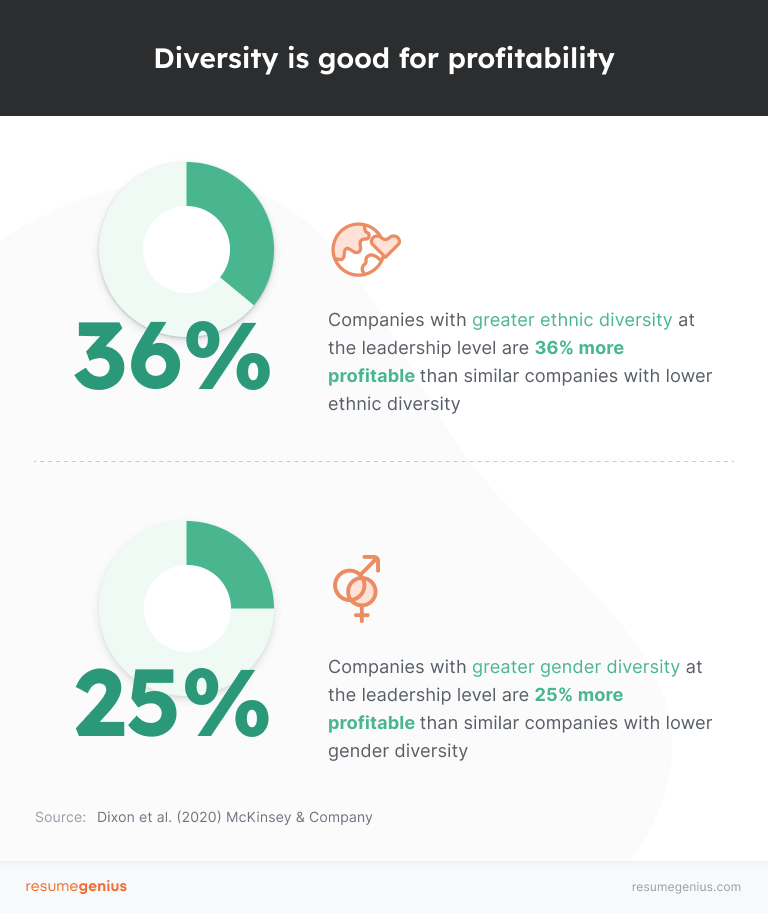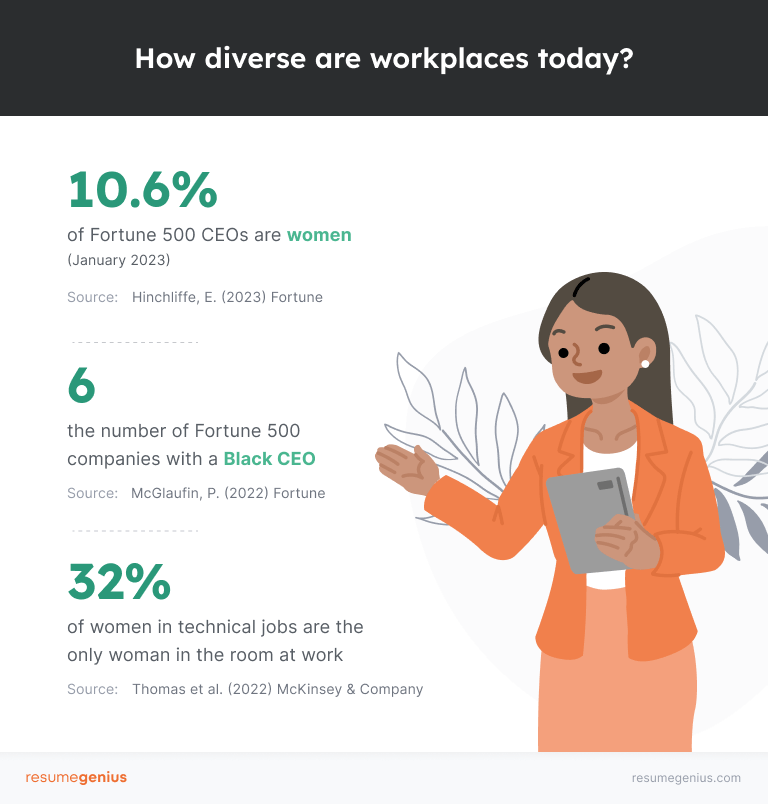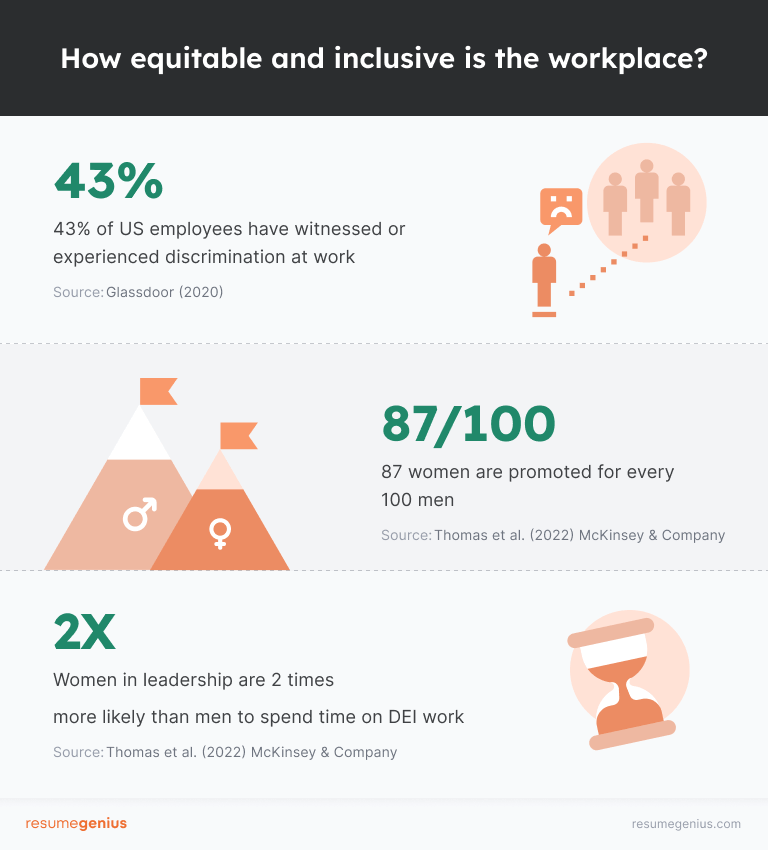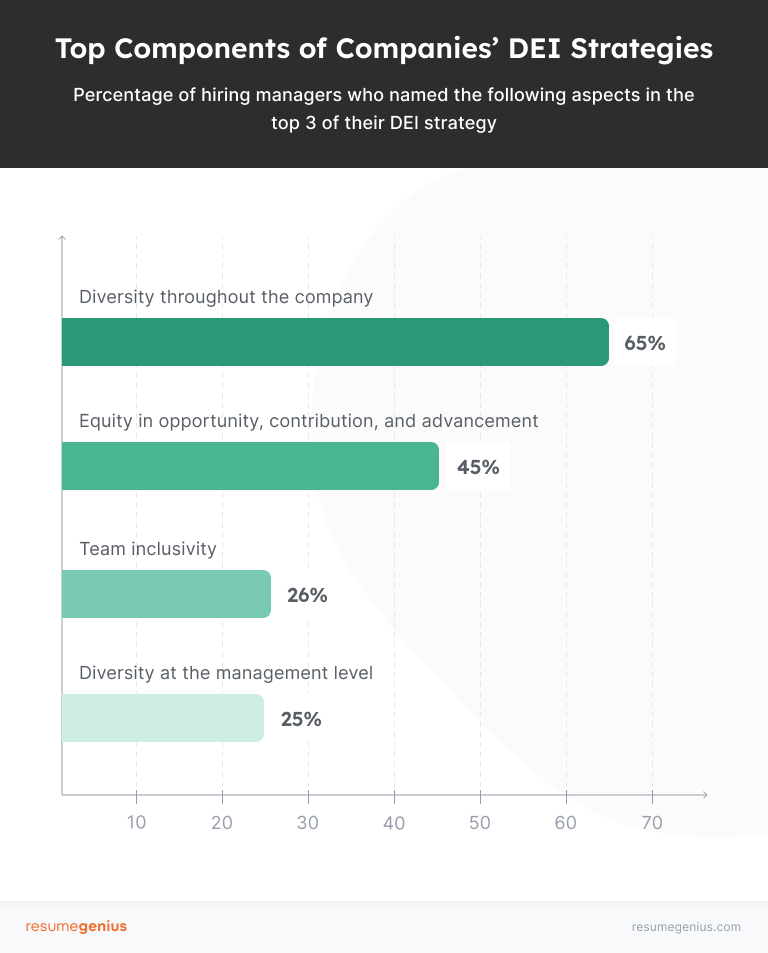While the journey towards greater diversity and inclusion may not always be smooth sailing, it’s an issue that businesses simply can’t afford to overlook.
Sourced from several credible sources, these diversity, equity, and inclusion (DEI) statistics highlight the growing importance of DEI to both employees and employers in 2024.
Our workplace diversity statistics cover the following areas:
DEI and the LGBTQIA2S+ community
- 9% of workers identified as LGBT, and less than a third strongly agreed that their organization genuinely cares about their well-being, treats them fairly, or will do the right thing about ethics or integrity issues (Gallup, 2022).
- 1 in 4 gay men and lesbians were open about their identity to their bosses (Proud Ventures, 2021).
- A rising number of Fortune 500 companies in 2021 offered benefits to their LGBTIQ+ employees: 96% included sexual orientation in their non-discrimination policies, 94% included gender identity, and 71% offered transgender-inclusive benefits (International Labour Organization, 2021).
- 1 in 4 LGBTQ+ entrepreneurs hide their identity from potential investors, with 18% doing so fearing it could impact their fundraising (Proud Ventures, 2021).
Benefits of diversity in the workplace (5 statistics)
The effects of workplace diversity on business performance are hard to measure, with factors such as company size, industry, culture, and other factors complicating studies. Even so, researchers have shown that diversity in the workplace provides several advantages.
- Companies with the greatest ethnic diversity (top 25%) at the leadership level are 36% more profitable than similar companies with the lowest ethnic diversity (bottom 25%) (McKinsey & Company, 2020).
- Companies with the greatest gender diversity at the leadership level (top 25%) are 25% more likely to have above-average profitability than similar companies with the lowest gender diversity (bottom 25%)(McKinsey & Company, 2020).
- Executive teams with more women (30+% female) are 48% more profitable than teams with less women (under 10% women)(McKinsey & Company, 2020).
- In 2020, respondents chose the top reasons to implement DEI at work. Some of their answers included the following (Workable, 2021):
- the right thing to do (50% named it in their top 3)
- needed to satisfy employee expectations (48%)
- helpful for attracting, engaging, and retaining talent (48%)
- providing business benefits, such as increased revenue and productivity (21%)
- 86% of business leaders say that incorporating DEI into everyday work and measuring outcomes is either important or very important to their organization’s success (Deloitte, 2023).
How important is workplace diversity to workers? (16 statistics)
Workplace diversity matters to employees, and often affects their decisions when deciding whether to stay at a current company or start writing a resume for a new job. And to minority groups and younger generations, workplace diversity is even more significant.
The state of workplace diversity in 2024 (22 statistics)
Several diversity landmarks have been achieved in 2022, such as the growing number of minority CEOs at Fortune 500 companies.
But while the US population is becoming more diverse, diversity at companies is lacking, not to mention equity and inclusion.
How diverse are workplaces today?
- Gen Z is more diverse than previous generations (Pew Research Center, 2020).
- Gen Z is 52% white, 25% Hispanic, 14% Black, 6% Asian, and 5% other.
- When Boomers were the same age as Gen Zers are today, 82% identified as white (compared to 52% of Gen Zers today).
- As of January 2023, 10.6% of Fortune 500 CEOs are women (Fortune, 2023).
- As of 2022, there are only 6 Fortune 500 companies with a Black CEO (Fortune, 2022).
- Only 1 in 4 C-suite leaders is a woman (McKinsey & Company, 2022).
- Only 1 in 20 C-suite leaders is a woman of color (McKinsey & Company, 2022).
- 32% of women in technical and engineering jobs are the only women in the room at work (McKinsey & Company, 2022).
- The average US company is projected to reach gender parity among executives in 29 years (McKinsey & Company, 2020).
How equitable and inclusive are workplaces today?
- 43% of US employees have either witnessed or experienced discrimination at work, including racism, sexism, ageism, and homophobia (Glassdoor, 2022).
- 47% of Black and 49% of Hispanic workers have quit their jobs after witnessing or experiencing discrimination at work (Glassdoor, 2020).
- Women earn 82 cents for every dollar men earn (U.S. Department of Labor Blog, 2021).
- For every 100 men who are promoted from entry-level to manager (McKinsey & Company, 2022):
- 87 women are promoted (the broken rung)
- 82 women of color are promoted
- 75 Latinas are promoted
- Women in leadership are 2 times more likely than men in equivalent positions to be mistaken for someone more junior (McKinsey & Company, 2022).
- 37% of women leaders have reported a coworker taking credit for their idea vs. 27% of men leaders in the same situation (McKinsey & Company, 2022).
- 12% of women leaders (compared to 6% of men leaders) have had someone say or imply that they’re not qualified (McKinsey & Company, 2022).
- 39% of women leaders have had their judgment questioned, compared to 28% of men leaders, with the number being especially high for Black women leaders (55%) (McKinsey & Company, 2022).
- 29% of women working on-site report experiencing microaggressions, compared to 19% of women working remotely (McKinsey & Company, 2022).
- Globally, the percentage of women hired into leadership roles has increased from 33% in 2016 to 37% in 2022 (World Economic Forum, 2022).
- Women in leadership are 2 times as likely as men in leadership to spend time on DEI work (McKinsey & Company, 2022).
- 52% of female leaders (senior managers or higher) are responsible for all of their family’s housework and childcare, whereas only 13% of male leaders are their family’s main caretaker (McKinsey & Company, 2022).
- The Hershey Company is a special case where women, Black, Latinx, and Asian employees earn the same salaries as white men (Hershey, 2021).
- 71% of employees would be more willing to share their experiences and thoughts on diversity and inclusion if they could do so anonymously (Glassdoor, 2020).
- 15% of companies are extremely confident that their employees feel belonging, inclusion, and psychological safety, compared to (Traliant and WBR Insights, 2021):
- 61% that feel only somewhat confident
- 24% that feel somewhat unconfident
Workplace diversity efforts (45 statistics)
Workplace diversity efforts skyrocketed between 2019 and 2020 but have since either slowed or stalled in the US. These statistics demonstrate that while employers and employees have good intentions, more needs to be done to fund, implement, and track diversity and inclusion.
General status of DEI efforts
- While 21% of companies reported exceeding industry norms regarding DEI, 49% felt they were on par and 30% felt they were below industry norms (Traliant and WBR Insights, 2021).
- In 2020, companies globally spent $7.5 billion on DEI-related efforts (Global Industry Analysts, Inc., 2021).
- Global spending on DEI-related efforts is projected to be $15.4 billion by 2026 (Global Industry Analysts, Inc., 2021).
- In 2021, workers reported on their organization’s DEI efforts, saying their company was doing (CNBC, 2021):
- “a lot” (33%)
- “some” (37%)
- “just a little” (14%)
- “nothing at all” (12%)
- When asked in 2021 how much of their company’s 2022 budget was allocated to DEI, workers responded that their company would (Traliant and WBR Insights, 2021):
- direct fewer resources and budgeting to DEI (2%)
- direct the same amount of resources and budget toward DEI (19%)
- allocate more budget and resources to DEI (79%)
- HR professionals reported that DEI (Workable, 2021):
- has always been important (37%)
- became important before 2020 (27%)
- became important in 2020 (18%)
- When asked how COVID-19 has affected DEI efforts, workers reported that the pandemic (Traliant and WBR Insights, 2021):
- boosted commitment to DEI (32%)
- did not affect DEI efforts (50%)
- negatively affected (such as by complicating or delaying) DEI efforts (18%)
- The top 5 metropolitan areas (defined by labor force size) that provide the greatest access to DEI programs are (Glassdoor, 2022):
- Seattle (73% of companies on Glassdoor)
- Las Vegas (71%)
- San Francisco (70%)
- Boston (68%)
- Charlotte (66%)
- 25% of business leaders feel prepared to incorporate and measure the outcomes of DEI in everyday work (Deloitte, 2023).
- Most companies (60%) don’t have any workers whose primary job is to drive DEI (DEI-dedicated roles), while 25% have one and 15% have more than one DEI-dedicated role (Culture Amp, 2022).
- Compared to 29% in 2019, 39% of companies in 2020 offered DEI programs as a benefit (Glassdoor, 2022).
- Down from 43% in 2021, 41% of companies on Glassdoor provide access to DEI programs as a benefit in 2022 (Glassdoor, 2022).
- 47% of recruiters plan to increase DEI efforts in 2023 (Monster, 2023).
Types of DEI efforts
- 41% of companies have a formal DEI policy (Culture Amp, 2022).
- 42% of companies that have a DEI policy don’t have a documented process for enforcing it (Culture Amp, 2022).
- 90% of companies have diversity goals (Syndio, 2022).
- 60% of companies hold DEI training (Culture Amp, 2022).
- 70% of companies purposefully source underrepresented candidates (Culture Amp, 2022).
- 18% of companies have an anonymous screening process (Culture Amp, 2022).
- 56% of companies have a DEI council or committee (Culture Amp, 2022).
- 18% of respondents named equity in compensation as one of the top 3 components of their company’s DEI strategy (Workable, 2021).
- The main components of companies’ DEI strategies in 2021 included achieving (Workable, 2021):
- diversity throughout the company (65% of respondents placed this in their top 3)
- equity in opportunity, contribution, and advancement (45%)
- team inclusivity (26%)
- diversity at the management level (25%)
- The top DEI priorities in 2022 were (Monster, 2022):
- building a diverse workforce (39% of employers)
- gender pay equity (36%)
- creating systems/processes to promote DEI, such as mentorship programs (28%)
- More Boomer recruiters (46%) emphasize gender pay equity, compared to 36% across all generations (Monster, 2022).
- 67% of Gen Z recruiters make efforts to recruit from diverse organizations, such as (Monster, 2022):
- Historically Black Colleges and Universities (HBCUs)
- community colleges
- trade schools
- local organizations that support underrepresented groups
DEI stakeholders
- Conversations advocating for increased DEI usually start with (Workable, 2021):
- executives/management (47% of companies)
- HR representatives (17%)
- non-HR employees (16%)
- Entry-level workers (29%) were more likely than executives (22%) to think that management should be accountable for DEI initiative outcomes (Workable, 2021).
- Around 39% of workers, from entry to executive levels, believe that everyone should be responsible for DEI initiatives (Workable, 2021).
- 24% of respondents believe that HR should be responsible for executing DEI initiatives (Workable, 2021).
Measuring DEI progress
- When asked to name DEI metrics that their organization measures, companies replied that they collect data regarding (Workable, 2021):
- demographics of the entire company (53% of companies put it in their top 3 choices)
- employee engagement and retention (31%)
- promotions and advancement to ensure equity (29%)
- representation at the executive/management level (24%)
- Companies measure and analyze many metrics of diversity, including (Syndio, 2022):
- gender (81% of companies)
- age (65%)
- race (65%)
- disability status (42%)
- veteran status (40%)
- caretaking responsibility (12%)
- refugee status (11%)
- Companies update employees on DEI goals and progress (Traliant and WBR Insights, 2021):
- every two years (33% of companies)
- every year (30%)
- every quarter (29%)
- more than once per quarter (8%)
- While 93% of companies discuss meeting business goals in manager performance evaluations, only 34% of companies report progress on diversity, equity, and inclusion (DEI) in their performance evaluations (McKinsey & Company, 2022).
- 40% of women leaders say that DEI work isn’t acknowledged in their performance reviews (McKinsey & Company, 2022).
Areas for improvement in DEI
- 11% of recruiters say that DEI programs are the first areas to be cut when reducing costs, along with company events and bonuses (Monster, 2023).
- 30% of US employees reported that their employer doesn’t hold the same values regarding DEI (Glassdoor, 2022).
- 46% of companies report that leadership isn’t held accountable if workplace equity initiatives fail (Syndio, 2022).
- DEI drivers (16%), HR professionals (20%), and employees (17%) are more likely than business leaders (11%) to say that leadership communicates about DEI infrequently or not at all (PwC, 2022).
- Most companies (89%) have a formal DEI strategy (while the other 11% don’t but plan to implement one within the next year) (Traliant and WBR Insights, 2021).
- 43% of companies have dedicated resources and a budget for their DEI efforts while 57% do not (Traliant and WBR Insights, 2021).
- 56% of companies recruit with DEI initiatives in mind, while 24% don’t but plan on emphasizing DEI when hiring in the future (Workable, 2021).
- Women leaders are more than 1.5 times as likely as men in equivalent positions to have left a job to work for a company that was more committed to DEI (McKinsey & Company, 2022).
- Minority groups (71% of Black and 72% of Hispanic employees) are more likely than white employees (58%) to think their employer should do more to increase workplace diversity (Glassdoor, 2022).
- Women (71%) are less likely than men (77%) to think that their company is making meaningful progress in DEI (Workable, 2021).
Sources
Learn more about workplace diversity using these resources.
- Culture Amp, “Workplace Diversity, Equity, and Inclusion Report: Understanding the DEI Landscape”
- CNBC, “CNBC and SurveyMonkey Release Latest Workforce Happiness Survey”
- Deloitte, “Taking Bold Action for Equitable Outcomes”
- Fortune, “The Number of Black Fortune 500 CEOs Returns to Record High — Meet the 6 Chief Executives”
- Fortune, “Women CEOs Run More Than 10% of Fortune 500 Companies for the First Time in History”
- Gallup, “LGBT Employee Experiences; Here’s What We Know”
- Glassdoor, “Diversity and Inclusion Workplace Survey”
- Glassdoor, “Glassdoor Launches Advanced Filters to Find Companies Highly Rated for Work/life Balance, Diversity & Inclusion, and More”
- Glassdoor, “Who Cares About Diversity, Equity, and Inclusion?”
- Global Industry Analysts, “With Global Spending Projected to Reach $15.5 Billion by 2026, Diversity, Equity, & Inclusion Takes the Lead Role in the Creation of Stronger Business”
- Hershey, “How We’re Holding Ourselves Accountable and Being Transparent in our Diversity, Equity, and Inclusion Goals”
- Indeed & Glassdoor, “Indeed & Glassdoor’s Hiring and Workplace Trends: Report 2023”
- International Labour Organization, “Inclusion of Lesbian, Gay, Bisexual, Transgender, Intersex and Queer (LGBTIQ+) Persons in the World of Work: A Learning Guide”
- McKinsey & Company, “Diversity Wins: How Inclusion Matters”
- McKinsey & Company, “LGBTQ+ Voices: Learning From Lived Experiences”
- McKinsey & Company, “Women in the Workplace 2022”
- Monster, “Monster Work Watch Report”
- Monster, “The Future of Work: 2022 Global Report”
- Pew Research Center, “On the Cusp of Adulthood and Facing an Uncertain Future: What we Know about Gen Z so Far”
- Proud Ventures, “The LGBTQ+ Founder Report”
- PwC, “Global Diversity, Equity, and Inclusion Survey”
- Statista, “U.S. Workers: Importance of Race, Gender, or Orientation to Identity by Community 2019″
- Syndio, “The 2023 Workplace Equity Trends Report”
- Traliant and WBR Insights, “How to Build an Effective DEI Program”
- Workable, “Diversity, Equity, and Inclusion in the Workplace: 2021 HR Survey”
- World Economic Forum, “Global Gender Gap Report 2022”
- U.S. Department of Labor Blog, “5 Facts About the State of the Gender Pay Gap”
About Resume Genius
Since 2009, Resume Genius has merged innovative technology with up-to-date industry expertise to simplify job hunting for people of all backgrounds and experience levels.
Resume Genius’s easy-to-use resume builder paired with a wide range of free career resources like resume templates, cover letter samples, and resume writing guides can help anyone improve their job hunt. Resume Genius has been featured in esteemed publications such as CNBC, Business Insider, Forbes, and The New York Times.
Supported by a team of dedicated career advisors and HR experts, Resume Genius’s ultimate mission is to guide job seekers toward fulfilling work and help them reach their career goals.
For media queries or concerns, please contact us.





